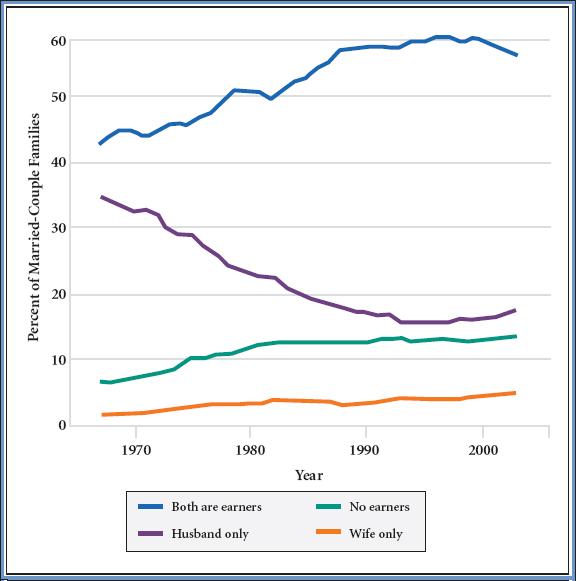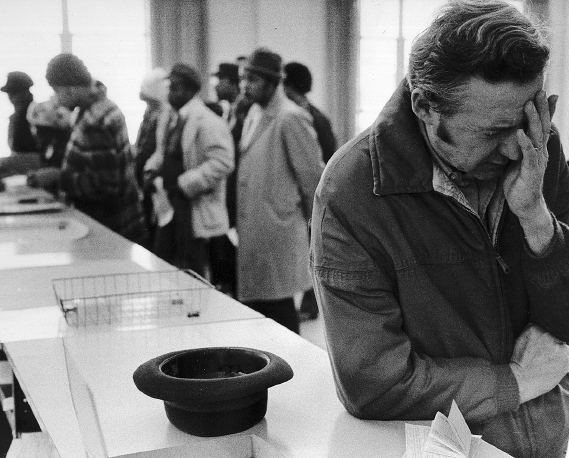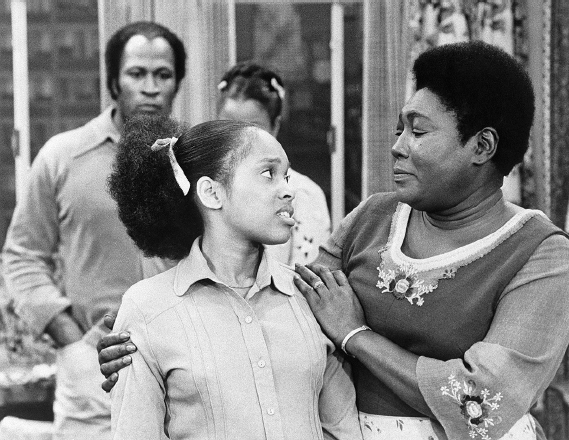America’s History: Printed Page 957
America: A Concise History: Printed Page 870
America’s History: Value Edition: Printed Page 848
Working Families in the Age of Deindustrialization
One of the most striking developments of the 1970s and 1980s was the relative stagnation of wages. After World War II, hourly wages had grown steadily ahead of inflation, giving workers more buying power with each passing decade. By 1973, that trend had stopped in its tracks. The decline of organized labor, the loss of manufacturing jobs, and runaway inflation all played a role in the reversal. Hardest hit were blue-collar and pink-collar workers and those without college degrees.

Women Enter the Workforce Millions of wives and mothers had worked for wages for decades. But many Americans still believed in the “family wage”: a breadwinner income, earned by men, sufficient to support a family. After 1973, fewer and fewer Americans had access to that luxury. Between 1973 and the early 1990s, every major income group except the top 10 percent saw their real earnings (accounting for inflation) either remain the same or decline. Over this period, the typical worker saw a 10 percent drop in real wages. To keep their families from falling behind, women streamed into the workforce. Between 1950 and 1994, the proportion of women ages 25 to 54 working for pay increased from 37 to 75 percent. Much of that increase occurred in the 1970s. Americans were fast becoming dependent on the two-income household (Figure 29.5).
The numbers tell two different stories of American life in these decades. On the one hand, the trends unmistakably show that women, especially in blue-collar and pink-collar families, had to work for wages to sustain their family’s standard of living: to buy a car, pay for college, afford medical bills, support an aging parent, or simply pay the rent. Moreover, the number of single women raising children nearly doubled between 1965 and 1990. Women’s paid labor was making up for the declining earning power or the absence of men in American households. On the other hand, women’s real income overall grew during the same period. This increase reflected the opening of professional and skilled jobs to educated baby-boomer women. As older barriers began to fall, women poured into law and medicine, business and government, and, though more slowly, the sciences and engineering. Beneficiaries of feminism, these women pursued careers of which their mothers had only dreamed.
Workers in the National Spotlight For a brief period in the 1970s, the trials of working men and women made a distinct imprint on national culture. Reporters wrote of the “blue-collar blues” associated with plant closings and the hard-fought strikes of the decade. A 1972 strike at the Lordstown, Ohio, General Motors plant captivated the nation. Holding out not for higher wages but for better working conditions — the plant had the most complex assembly line in the nation — Lordstown strikers spoke out against what they saw as an inhumane industrial system. Across the nation, the number of union-led strikes surged, even as the number of Americans in the labor movement continued to decline. In Lordstown and most other sites of strikes and industrial conflict, workers won a measure of public attention but typically gained little economic ground.


When Americans turned on their televisions in the mid-1970s, the most popular shows reflected the “blue-collar blues” of struggling families. All in the Family was joined by The Waltons, set during the Great Depression. Good Times, Welcome Back, Kotter, and Sanford and Son dealt with poverty in the inner city. The Jeffersons featured an upwardly mobile black couple. Laverne and Shirley focused on young working women in the 1950s and One Day at a Time on working women in the 1970s making do after divorce. The most-watched television series of the decade, 1977’s eight-part Roots, explored the history of slavery and the survival of African American culture and family roots despite the oppressive labor system. Not since the 1930s had American culture paid such close attention to working-class life.
The decade also saw the rise of musicians such as Bruce Springsteen, Johnny Paycheck, and John Cougar (Mellencamp), who became stars by turning the hardscrabble lives of people in small towns and working-class communities into rock anthems that filled arenas. Springsteen wrote songs about characters who “sweat it out in the streets of a runaway American dream,” and, to the delight of his audience, Paycheck famously sang, “Take this job and shove it!” Meanwhile, on the streets of Harlem and the South Bronx in New York, young working-class African American men experimenting with dance and musical forms invented break dancing and rap music — styles that expressed both the hardship and the creativity of working-class black life in the deindustrialized American city.
PLACE EVENTS IN CONTEXT
Question
Why did the struggles of working families become more prominent in the 1970s, and what social and economic concerns did those families have?